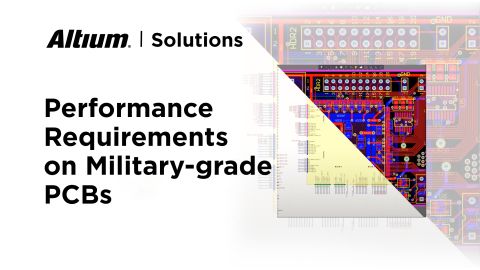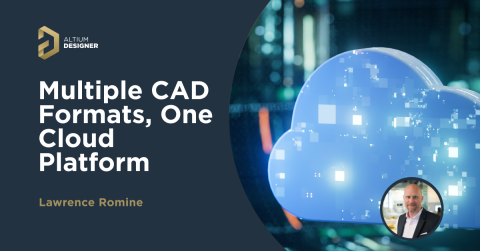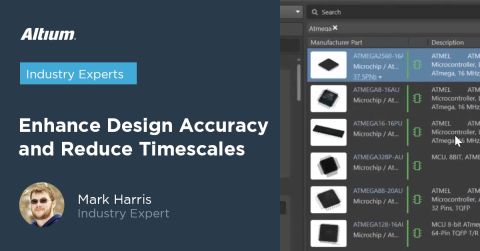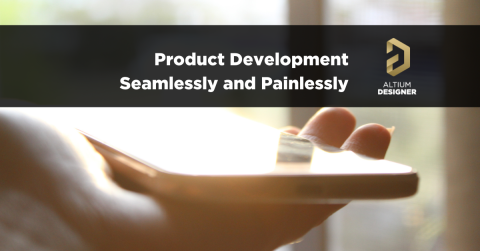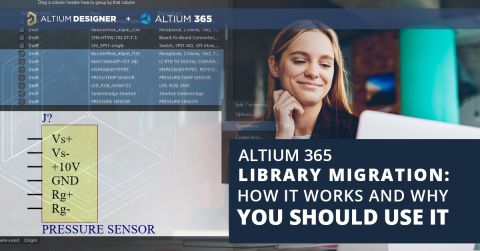Using Product Lifecycle Management (PLM) Components Software for PCB Design

Any product, including circuit boards and electronic components, will become obsolete and must be replaced with completely new versions. If a product is ever manufactured and taken to market, the product and its components will inevitably have a finite life cycle. Products are eventually upgraded to new versions and capabilities or components are added, or they become obsolete and are replaced with completely new circuit designs and technology. Managing these aspects of the product life cycle for electronics and the printed circuit boards that support them requires a suite of design and management tools.
Only one software package can be found on the market that integrates industry-standard design capabilities with data exchange and management features into a single program: Altium Designer. These management tools should do more than keep track of part numbers; you’ll need to watch for obsolescence in the components life cycle. With the supply chain visibility tools, CAD tools, and design engine in Altium Designer, you can turn any idea into a finished product and manage its life cycle along the way.
ALTIUM DESIGNER®
A unified PCB design package with the best product lifecycle management software tools for modern electronic components and circuit boards.
Product lifecycle management: it’s one of those business processes that is thrown around by industry types, but designers may not understand how it affects product design, design reuse, and product development for new electronics and the circuit boards that support them. Managing product design, development, manufacturing, and distribution are just one aspect of taking a new product to market. Once a new product hits the market and remains in demand, the supply chain and future manufacturing runs need to be managed in order to satisfy demand.
Managing the product lifecycle with a PLM solution provides other benefits beyond decreasing time to market and keeping up with customer demand. Incorporating product lifecycle management into the design process helps decrease prototyping production costs and errors, reduce time to market, and hasten redesigns through the reuse of existing design blocks and data. These benefits can be realized in a number of industries, they are not just limited to circuit boards and electronics.
When it comes to printed circuit board design and production, product lifecycle management provides these same benefits, but it requires the right design and management software. With the right design platform, you can create new circuit boards, plan for production, manage design data, reuse schematics, and release new versions of products in a single program. You can address and overcome common problems involved in product life cycle management when your circuit design software integrates these important features into a single program with a unified knowledge management workflow.
The Role of a PLM Solution in the Product Development Process
The graph below shows a general life cycle for any new technology, including circuit boards and electronics. The life cycle begins with the standard product development process and market introduction. Eventually, the components that make up the product will go obsolete, and the product life cycle will come to an end. Obsolescence of components is the major reason for the end of a circuit board’s life cycle.

Typical product life cycle. In printed circuit design and electronics, components eventually go obsolete, and the circuit board needs to be upgraded or replaced completely.
Product life cycle management and circuit design may seem like separate business processes, but the two are intimately related. Companies that implement continuous innovation must continuously improve their circuits designs with new components as new technology becomes available. Eventually, a product will become obsolete and will require major changes, or even entirely new circuit architecture.
Product lifecycle management software can be your PL solution and solve both problems at once by providing supply chain visibility and obsolescence information during sourcing. When this solution is integrated into your PCB design software, you can immediately identify soon-to-be obsolete components in your printed circuit board and plan to redesign circuits during the product development process.
Component Sourcing Data in Product Lifecycle Management Software
Some common problems in the life cycle management process arise due to a lack of sourcing information throughout the design process, lack of access to component model updates and obsolescence information, and a scattered documentation repository. Problems that fall into these three categories can seriously hamper the design process for circuit boards, as well as planning for manufacturing and sourcing. Keeping documentation in a consistent format with a consistent file structure allows design teams to easily track product updates and new capabilities as products are continuously innovated and modernized.
Obsolescence management is a very important part of developing and manufacturing any new piece of technology. Your new product should compete with other products on every level as soon as it hits the market, meaning you need to include the most up-to-date components in your circuit boards. Having real-time access to supply chain information helps you identify which components in your design will become obsolete before you release your design to the market.
- The product lifecycle management process for printed circuits mimics that seen in other industries. Keeping meticulous documentation and organizing design data are the best ways to be responsive throughout the product life cycle.
Learn more about the product life cycle for printed circuit boards.
- ECAD tools play an important role in life cycle management for printed circuit boards and electronic products. Your sourcing data should appear in your BOM and should be pulled directly from your component libraries.
Learn more about the role of ECAD tools in product life cycle management.
- When your design features are built for data exchange in a single environment, your design and data management business processes become seamless and your data is easily passed between your design and documentation tools.
Learn more about design tools that are built on data exchange principles.

Accessing sourcing and supply chain data in Altium Designer
Keeping up with Change During the Product Development Process
In order to keep up with change, your design software needs to help you identify obsolete components in your printed circuit board and your schematic so that you can immediately replace them. Replacements need to be chosen based on updated supply chain information. Finally, updates to component data need to pass directly to your PCB libraries. This prevents your data from going stale and allows your designs to keep up with changes in the manufacturing supply chain and technology in general.
Here’s what to watch for during product life cycle management:
- Price changes for components. This helps you project whether your product can remain competitive.
- Library updates. You’ll need to make sure the most recent versions of models and sourcing data for components are imported into your PCB libraries.
- Life cycle statuses. Components will eventually go not recommended for new designs (NRND), and suitable replacements need to be found for your product life cycle to continue.
Libraries, Components, and Sourcing Data in Your Circuit Design Software
Your PCB libraries play a special role in the product development process. They do more than just hold a list of components and part numbers. They contain PCB footprints, schematics, and PCB footprints, all organized into a specific structure for circuit design and sourcing. The right PCB design software also provides product life cycle management software functions. PCB designers and project managers source current components for their circuit designs and remain competitive in the marketplace. Integrated tools also help project managers ensure new products are manufacturable, ultimately decreasing time to market.
- Your design documentation should contain real-time supply chain information for your circuit board. A product lifecycle management tool helps you build complete and accurate documentation for your manufacturer.
Learn more about generating documentation as part of product life cycle management.
- Library management in an important part of the product development process. You can quickly compile and organize your circuit design data, making it accessible to anyone on your design team.
- Integrated PLM software brings updated design data directly into your PCB design software. Your product lifecycle management and design processes become seamless when your data passes between design and documentation tools.
Learn more about defining a data management process for your organization.

Supply chain data and obsolescence are easily visible in Altium Designer
PLM Software Aids Each Manufacturing Run
PLM software also has a role to play in manufacturing. Part of lifecycle management for electronics involves keeping an eye on the components supply chain to ensure components for your product remain sourceable. As components begin to become obsolete and new versions are planned for release, the product lifecycle resets as your product is updated to use these new components. Each new manufacturing run for your product will also require updated sourcing information for the components that appear in your design.
In the event that critical components are unavailable or obsolete, they need to be quickly exchanged for suitable replacements. The PLM software functions in your PCB design package should quickly create updated documentation from your design data so that you can get to manufacturing quickly. The best software for these life cycle management tasks provides all your important tools in a single program. Your design and PLM software application should take this data and generate consistent documentation, making it easy to track design revisions and begin new manufacturing runs for your product.

End the product development process successfully with accurate manufacturer documentation and sourcing data.
Altium Designer: Unified Circuit Design and PLM Software
Altium Designer is the only printed circuit design software that places all your design, documentation, component sourcing, and data management features into a single program. Adding a powerful product lifecycle management solution like Altium Concord Pro to Altium Designer ensures that your design data is always current. It also helps you choose suitable replacement components when needed, which expedites redesigns and revisions of old products, but also makes for convenient design reuse for up to date schematics.
- Altium Designer unifies CAD tools with PLM software functions to create a powerful sourcing data management system for circuit board design.
See how Altium Designer creates a unified environment for PCB design.
- Altium Designer's real-time supply chain data and integrated PCB libraries give you everything you'd expect in a product lifecycle management tool. Your PCB libraries and supply chain information will remain current with Altium Designer.
Learn more about PLM and supply chain management in Altium Designer.
- Altium Designer also includes a Manufacturer Part Search tool for finding real-time sourcing data and component models alongside your CAD tools.
Learn more about tools you can use for sourcing components in Altium Designer.
Proper product lifecycle management for circuit boards and components is best done within a unified environment, where CAD tools are accessible alongside your product data management features. If you want to streamline the product design process and product data management, then you need to work with Altium Designer, the only unified design and product data management platform. Instead of using different platforms for CAD tools, sourcing components, and manage product data, try using the only design platform with integrated PLM software features. It’s time to make the switch to Altium Designer.
Altium Designer on Altium 365 delivers an unprecedented amount of integration to the electronics industry until now relegated to the world of software development, allowing designers to work from home and reach unprecedented levels of efficiency.
We have only scratched the surface of what is possible to do with Altium Designer on Altium 365. You can check the product page for a more in-depth feature description or one of the On-Demand Webinars.

